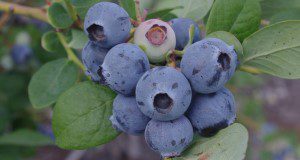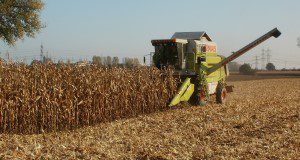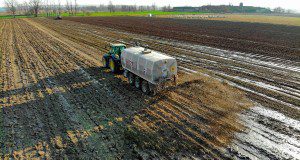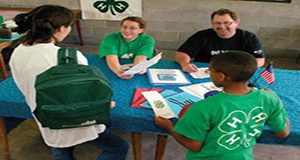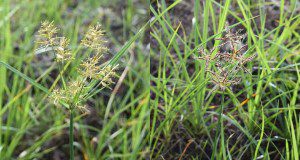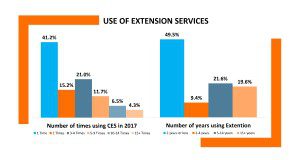Good agricultural practices (GAPs) and good handling practices (GHPs) encompass the general procedures growers, packers, and processors of fresh fruits and vegetables should follow to ensure the safety of their product. GAPs usually address preharvest practices (i.e., in the field), while GHPs cover postharvest practices, including packing and shipping. This 7-page fact sheet covers GAPs and GHPs relating to water use. This major revision is a part of the Food Safety on the Farm series and was written by Jaysankar De, Christopher R. Pabst, Jessica Lepper, Renée Goodrich-Schneider, and Keith R. Schneider and published by the UF/IFAS Food Science and Human Nutrition Department.
http://edis.ifas.ufl.edu/fs136
Author: Paul Roberts
Green Power in the Garden: A Simple Water Feature Using Photovoltaic Solar Panels
In this new 4-page publication from the Environmental Horticulture Department, Edmund Lee Thralls presents a basic method of how to construct a solar-powered water feature in your garden.
http://edis.ifas.ufl.edu/ep571
Botryosphaeria Stem Blight on Southern Highbush Blueberry in Florida
Botryosphaeria stem blight is the most common and damaging fungal vascular disease on southern highbush blueberry in the southern United States, causing stem and cane dieback and reductions in yield. Advanced stages of this disease may cause premature plant death, which results in significant replanting costs for growers. Biotic or abiotic stresses from a variety of sources can make plants more susceptible to infection by stem blight pathogens. This new 5-page publication is intended for Florida blueberry growers to use as a guide in the identification and management of Botryosphaeria stem blight on southern highbush blueberry. Written by Norma C. Flor, Douglas A. Phillips, and Philip F. Harmon and published by the UF/IFAS Plant Pathology Department.
http://edis.ifas.ufl.edu/pp347
Developing a Mentorship Program in Higher Education Institutions
Higher education institutions are currently tackling a growing number of organizational challenges that have forced departments to evolve their business practices. Administrators faced with the need for more diverse programs must decide whether to develop talent internally or recruit new qualified candidates. Given the great cost of faculty searches and the perceived diminishing availability of talented applicants, it is imperative that administrators understand the value of mentoring relationships to fill openings with qualified candidates. However, formal mentoring programs have been slow to develop in higher education institutions. This new 4-page publication defines mentorship, explains the value of mentorship, and describes how mentoring programs can be established. Written by Jonathan M. Orsini, Matthew P. Benge, and Hannah S. Carter, and published by the UF/IFAS Department of Agricultural Education and Communication.
http://edis.ifas.ufl.edu/wc328
Biology and Management of Spanish Needles (Bidens spp.) in Ornamental Crop Production
All eight species of Bidens in Florida are commonly referred to as Spanish needles or beggar-ticks. This document focuses on Bidens alba and B. pilosa, which are common weeds in container nurseries and landscapes in Florida. This 6-page EDIS publication, written by Yuvraj Khamare, Chris Marble, Shawn Steed, and Nathan Boyd and published by the UF/IFAS Environmental Horticulture Department, is designed for landowners, gardeners, horticulturalists, and consumers hoping to learn more about Spanish needle classification and management.
http://edis.ifas.ufl.edu/ep572
Southern Highbush Blueberry Cultivars from the University of Florida
Southern highbush blueberries combine the fruit quality and productivity of highbush blueberries with the low chilling requirement necessary to produce a crop in the Florida climate. Written by J. G. Williamson, D. A. Phillips, P. M. Lyrene, and P. R. Munoz and published by the UF/IFAS Horticultural Sciences Department, this 13-page major revision describes current and historical southern highbush blueberry cultivars released by the University of Florida.
http://edis.ifas.ufl.edu/hs1245
Food Safety on the Farm: Good Agricultural Practices and Good Handling Practices: Field Sanitation
Good Agricultural Practices (GAPs) and Good Handling Practices (GHPs) encompass the general procedures that growers, packers, and processors of fresh fruits and vegetables should follow to ensure the safety of their product. GAPs usually deal with preharvest practices (i.e., in the field), while GHPs cover postharvest practices, including packing and shipping. This 5-page fact sheet covers harvest practices associated with sanitation in the field, including basic principles for microbial food safety and control of potential hazards. This major revision is a part of the Food Safety on the Farm series and was written by Jessica Lepper, Jaysankar De, Christopher Pabst, Renée Goodrich-Schneider, and Keith Schneider and published by the UF/IFAS Food Science and Human Nutrition Department.
http://edis.ifas.ufl.edu/fs160
Food Safety on the Farm: Good Agricultural Practices and Good Handling Practices: Traceback
Good Agricultural Practices (GAP) and Good Handling Practices (GHP) are voluntary audits that verify fruits and vegetables are produced, packed, handled, and stored as safely as possible to keep the risks of microbial food safety hazards at the minimal level. Good Agricultural Practices usually deal with preharvest practices (i.e., in the field), while GHPs cover postharvest practices, including packing and shipping. This 3-page fact sheet in the Food Safety on the Farm series covers GAPs and GHPs relating to traceback, or the ability to track food items, such as fresh produce, back to their source. This major revision was written by Jaysankar De, Christopher R. Pabst, Alexandra S. Chang, Renée M. Goodrich-Schneider, and Keith R. Schneider and published by the UF/IFAS Food Science and Human Nutrition Department.
http://edis.ifas.ufl.edu/fs152
Food Safety on the Farm: Good Agricultural Practices and Good Handling Practices: Manure and Municipal Biosolids
Good Agricultural Practices (GAPs) and Good Handling Practices (GHPs) encompass the general procedures growers, packers, and processors of fresh fruits and vegetables should follow to ensure the safety of their product. GAPs usually deal with pre-harvest practices (i.e., in the field), while GHPs tend to cover post-harvest practices, including packing and shipping. This 5-page entry in the Food Safety on the Farm series focuses on Good Agricultural Practices, including pathogen reduction and handling and application, to control potential hazards when working with manure and biosolids. This major revision was written by Jaysankar De, Christopher R. Pabst, Jessica Lepper, Renée M. Goodrich-Schneider, and Keith R. Schneider and published by the UF/IFAS Food Science and Human Nutrition Department.
http://edis.ifas.ufl.edu/fs150
How to Establish an Urban Agriculture Ordinance
While the desire to implement urban agriculture projects is growing in popularity, there is little information available to help Extension agents and interested citizens fully understand how to implement urban agriculture in their community. This new 11-page document provides an overview of key information required to establish an urban agriculture ordinance. Case studies from urban agriculture initiatives in Florida provide real-world examples of the required activities, potential challenges, and beneficial partners for implementing these initiatives. Resources related to the case studies and additional urban agriculture resources can be found at the end of the document, so that readers can find further information specific to their interests and needs. Written by Candace A. Spencer, Catherine G. Campbell, Anna Prizzia, and Liz Felter, and published by the UF/IFAS Horticultural Sciences Department.
http://edis.ifas.ufl.edu/hs1327
Preventing Foodborne Illness: Yersiniosis
 Yersiniosis is an infectious disease caused by the bacterium Yersinia and is typically associated with the consumption of contaminated food or liquids. Yersiniosis is characterized by common symptoms of gastroenteritis such as abdominal pain and mild fever. The bacterium is prevalent in the environment, enabling it to contaminate water and food systems. Outbreaks of yersiniosis have been associated with improperly pasteurized milk, ready-to-eat salad mix, oysters, and more commonly with consumption of undercooked meals containing pork. Yersiniosis incidents have been reported frequently in Northern Europe, Scandinavia, and Japan, and rarely in the United States. However, the reported low incidence of Yersinia in the US food supply may be underestimated due to the long incubation time and misdiagnosis of patients with Y. enterocolitica infections, along with the inability to identify the source of infection and the fact that only serious cases are reported. This 4-page major revision, written by Christopher Pabst, Jaysankar De, Aswathy Sreedharan, Correy Jones, and Keith R. Schneider and published by the UF/IFAS Food Science and Human Nutrition Department, also describes long-term effects and complications of yersiniosis, members of the population most at risk, and prevention methods.
Yersiniosis is an infectious disease caused by the bacterium Yersinia and is typically associated with the consumption of contaminated food or liquids. Yersiniosis is characterized by common symptoms of gastroenteritis such as abdominal pain and mild fever. The bacterium is prevalent in the environment, enabling it to contaminate water and food systems. Outbreaks of yersiniosis have been associated with improperly pasteurized milk, ready-to-eat salad mix, oysters, and more commonly with consumption of undercooked meals containing pork. Yersiniosis incidents have been reported frequently in Northern Europe, Scandinavia, and Japan, and rarely in the United States. However, the reported low incidence of Yersinia in the US food supply may be underestimated due to the long incubation time and misdiagnosis of patients with Y. enterocolitica infections, along with the inability to identify the source of infection and the fact that only serious cases are reported. This 4-page major revision, written by Christopher Pabst, Jaysankar De, Aswathy Sreedharan, Correy Jones, and Keith R. Schneider and published by the UF/IFAS Food Science and Human Nutrition Department, also describes long-term effects and complications of yersiniosis, members of the population most at risk, and prevention methods.
http://edis.ifas.ufl.edu/fs193
Florida 4-H Secretary Record Book
The Florida 4-H Secretary record book will provide the club secretary with an official outline for tracking all club records. This 30-page book serves as a guide and should be completed annually by the 4-H club secretary. This major revision was written by Sarah Thomas Hensley and Stacey Ellison and published by the UF/IFAS Extension 4-H Youth Development program.
http://edis.ifas.ufl.edu/4h011
Biology and Management of Yellow (Cyperus escuelentus) and Purple Nutsedge (C. rotundus) in Ornamental Crop Production and Landscapes
This new six-page document provides insight on characteristics and management techniques for both yellow and purple nutsedge, prevalent and persistent weeds in Florida. Written by Debalina Saha, Chris Marble, Nathan Boyd, and Shawn Steed and published by the UF/IFAS Environmental Horticulture Department, March 2019.
http://edis.ifas.ufl.edu/ep569
Formation of Citrus Canker Lesions
Citrus canker is a non-systemic bacterial disease that affects citrus trees in both the citrus nursery and in commercial plantings. This poster is designed to assist citrus nursery workers in the identification of citrus canker. This one-page document was written by Jamie Burrow, Megan Dewdney, Ajia Paolillo, and Tim Riley and published by the UF/IFAS Plant Pathology Department.
http://edis.ifas.ufl.edu/pp346
Key Plant, Key Pests: Holly (Ilex sp.)
This series of Key Plant, Key Pests publications are designed for Florida gardeners, horticulturalists, and landscape professionals to help identify common pests associated with common Florida flora. This publication, the eighth in the Key Plant, Key Pests series, helps identify the most common pests found on Holly (Ilex sp.). This publication provides information and general management recommendations for Florida wax scale, tea scale, Cylindrocladium leaf spot, dieback, Sphaeropsis gall, root knot nematodes, and magnesium deficiency. This five-page document was written by Juanita Popenoe, Caroline R. Warwick, Jacqueline Bourdon, and Liz Felter and published by the UF/IFAS Department of Environmental Horticulture.
http://edis.ifas.ufl.edu/ep566
Clients’ Experience with FCES: Widespread Satisfaction Tempered with Suggestions for Improvement
The Florida Cooperative Extension Service (FCES) provides a variety of information to clients throughout the state. In order to determine the extent of client satisfaction, the FCES conducts an annual survey. The survey was sent to a sample of clients who have received educational information between March and July, 2017. A total of 1,202 participants responded, and 94.9% of Extension clients reported that they were satisfied or very satisfied with the overall services provided. Many Extension clients also shared suggestions for improving services, including improved communication, increased advertising, and increased availability for some classes. In this five-page document from the UF/IFAS Department of Agricultural Education and Communication, Glenn D. Israel and Tiffany Henderson summarize the results of the survey and provide recommendations for how to improve Extension’s services.
http://edis.ifas.ufl.edu/wc326
Educating Your State Legislators
Both legislators and citizens play important roles in ensuring a fair and effective state government. Florida State Representatives and Senators have a responsibility to represent the will of their constituents. Similarly, citizens have a responsibility to educate their Representatives and Senators on how issues may impact them and other local citizens. This three-page guide walks you through the process of making your voice heard and provides some helpful tips to make your message to your legislator stand out. Written by Stacey Ellison and published by the UF/IFAS 4-H Youth Development Department, March 2019.
http://edis.ifas.ufl.edu/4h397





